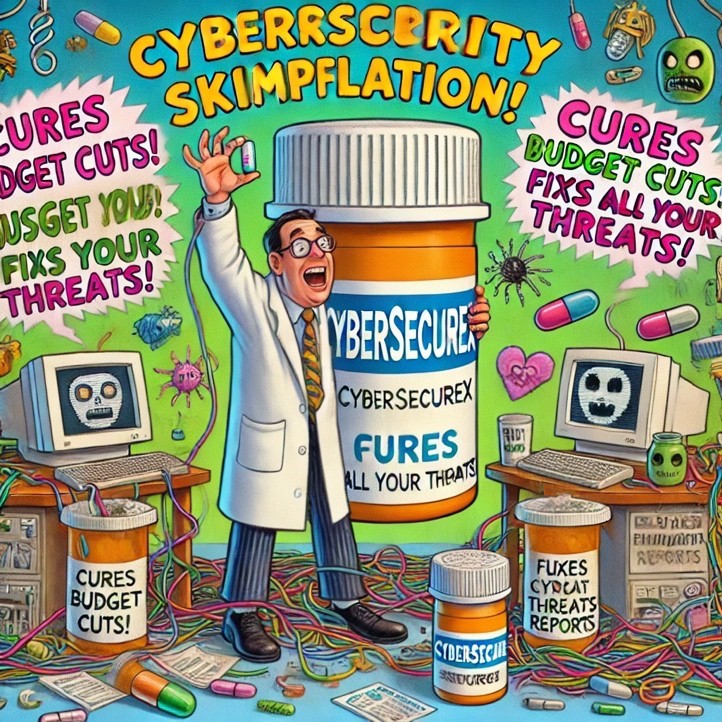
“Are you experiencing an increased attack surface, unpatched vulnerabilities, or long hours spent chasing phantom alerts? Do you find your security team stretched thinner than avocado on artisanal toast? If so, you might be suffering from Cybersecurity Skimpflation.
Side effects may include sleepless nights, exasperated audits, regulatory fines, and occasionally, catastrophic breaches. But don’t worry—you’re not alone! Cybersecurity Skimpflation is sweeping the corporate world, leaving organizations everywhere more exposed than a penguin in a heatwave.
What Is Cybersecurity Skimpflation?
Simply put, it’s what happens when your company dreams big but spends small. Picture this: your organization wants to implement cutting-edge threat detection, shift everything to the cloud, and dazzle auditors with its zero-trust architecture. But instead of boosting the budget, it slashes it, consolidates tools, and tells the security team to “just make it work.” The result? A haphazard patchwork of defenses that looks more like a Swiss cheese sandwich than a cybersecurity strategy.
Recognizing the Symptoms
Cybersecurity Skimpflation sneaks up on you. One day, you’re fine-tuning your SIEM to perfection, and the next, you’re staring at a budget spreadsheet that makes you cry in binary. Here are some tell-tale signs:
- Overworked Teams: If your SOC team starts quoting Shakespeare (“When shall we three meet again?”), they might be too overburdened to fight off attackers effectively.
- Tech Tool Tetris: Tools get swapped out like socks in a, and suddenly, your once-cozy security stack is just one big, mismatched mess.
- Compliance Gymnastics: Regulatory requirements are now achieved with the grace of a toddler at their first dance recital—barely.
How Did We Get Here?
Cybersecurity Skimpflation is a classic case of champagne tastes on a beer budget. Companies want all the bells and whistles but aren’t ready to pony up for the orchestra. Add in some inflation, a global talent shortage, and a rapidly evolving threat landscape, and voilà! Your security posture starts to resemble a Jenga tower: one wrong move, and it all comes crashing down.
The Real Costs
While skimping might save a few bucks upfront, the long-term effects are as nasty as forgetting your password after turning on two-factor authentication. Data breaches, reputational damage, and fines can cost exponentially more than the savings from cutting corners. Plus, morale in your security team plummets faster than your network under a DDoS attack.
Is There a Cure?
The good news? Cybersecurity Skimpflation is treatable. Organizations can reclaim their resilience by:
- Investing in scalable, intelligent tools (hello, automation!)
- Hiring and retaining top talent by valuing their work (and giving them PTO)
- Auditing their priorities to ensure resources match ambitions
And remember: the best medicine is prevention. A well-funded, well-staffed security team is cheaper than a breach response hotline.
So, the next time someone at the top says, “Do we really need to spend more on cybersecurity?” just ask them this: “Do you want to pay now, or after the ransomware note comes in emojis?” Cybersecurity Skimpflation may be common, but with the right strategy, it doesn’t have to be your company’s diagnosis. Stay secure, stay sane—and for goodness’ sake, stay funded!
“This concept may not be suitable for organizations unwilling to invest in basic cybersecurity hygiene. Side effects may include mild budget increases, overly optimistic board meetings, and a sudden realization that your password policy is embarrassingly outdated. Do not use if you plan to ignore patch management, forget to back up critical data, or rely on Gary from IT to single- handedly fend off nation-state attackers. Results may vary based on threat landscapes, compliance deadlines, and whether or not Karen in accounting clicks on phishing emails. Consult your CISO to see if this approach is right for you. The author of this publication is not responsible for ransomware attacks, shadow IT, or anyone still running Windows XP in 2024.”

Author: Aaron Rinehart
Aaron has spent his career solving complex challenging engineering problems
and transforming cyber security practices across a diverse set of industries:
healthcare, insurance, government, aerospace, technology, higher education, and the military. He has been expanding the possibilities of chaos engineering in its application to other safety-critical portions of the IT domain, most notably in cybersecurity
